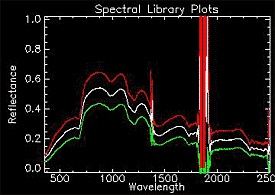Spectral mixture analysis (SMA) is an image processing technique for estimating cover fractions of surface component materials at the subpixel level from hyperspectral or multispectral imagery. It assumes that pixel reflectance is a function of the proportion of surface materials that comprise that pixel. A commonly applied algorithmic constraint of SMA is that these proportions sum to unity. Cover fractions of green vegetation, non-photosynthetic vegetation, soil, etc. vary greatly at fine (subpixel) scales, in both burned and unburned scenes. Since SMA is based on this valid assumption, SMA can be usefully applied whether the resolution is 500 m (e.g., MODIS satellite) or 5 m (e.g., airborne hyperspectral).

Since SMA estimates cover fractions directly, the outputs are more intuitive to those not familiar with remote sensing terms and techniques. Thus, a soil fractional cover map derived from SMA can be less subject to misinterpretation than a burn severity index such as the Normalized Burn Ratio (NBR), from which one must then infer the biophysical characteristic of interest (e.g., percent soil exposure). The major disadvantage of SMA-based cover fraction maps relative to NBR-based maps is that the latter can be produced quickly, with minimal image processing, while the application of SMA requires collection or derivation of spectral endmembers.
Spectral endmembers are the reflectance spectra of the "pure" component materials that occur in the scene. A common approach to gathering spectral endmembers is to collect them on the ground using a field spectroradiometer. In our study, we used an ASD FieldSpec Pro FR (Analytical Spectral Devices, Boulder, CO). The ASD FieldSpec Pro FR has sufficiently small sampling intervals of 1.4 nm for the region 350 - 1050 nm and 2 nm for the region 1000 - 2500 nm. The result is a continuous reflectance spectrum in the 350-2500 nm portion of the electromagnetic spectrum. Thus, endmembers from this instrument can be used to unmix reflectance spectra from images having spectral bands within these wavelengths.
An objective of this project was to form a spectral library of endmembers of the major surface component materials encountered on the wildfires we sampled in western Montana mixed conifer forest, southern California chaparral, and interior Alaska spruce forest. Within each of these three regions, we have further organized the spectral endmembers into functional groups: 1. green (photosynthetic) vegetation, 2. non-photosynthetic vegetation, 3. soil and/or rock, and 4. char and/or ash spectra. A digital photo of the endmember material, a graph of the endmember spectrum, and a downloadable ASCII file of the actual spectrum is provided. We encourage users to download these endmember spectra for SMA of imagery within these regions, both for burn severity or other applications. We hope to continue to build upon this spectral library.
Additional Information
A large Spectral Library, particularly of minerals, is maintained by USGS. To avoid redundancy, we have focused more on vegetation endmembers. Please contact us if you would like to add endmembers of your own to this library.